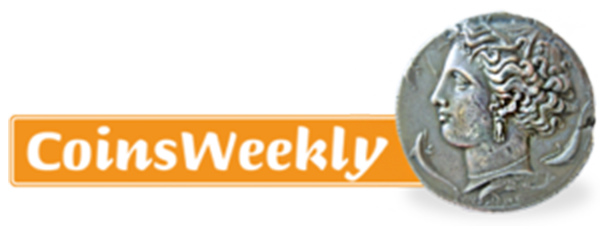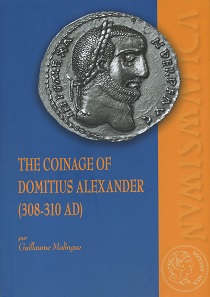Written by Ursula Kampmann
Translated by Leonie Schulze
December 6, 2018 – A new standard reference work has been published and it’s one that every coin dealership needs if it wants to seriously engage in selling coins of the Roman Empire. Guillaume Malingue presents a catalog containing all of the known coins of emperor Domitius Alexander. It is a catalog you must cite from now on if you want to sell coins of the emperor Domitius Alexander.
Guillaume Malingue, The Coinage of Domitius Alexander (308-310 AD). Ausonius Éditions, Bordeaux 2018. 172 pp. Illustrations in black and white. Paperback. 21 x 29.6 cm. ISBN: 978-2-35613-231-4. 35 euros.
The author discards 35 out of “only” 205 known coins of this emperor as forged. Those 35 coins are partly found in some of the most important museums and partly in private collections. The provenance information of those 35 coins can be traced up to auctions held in 2017. Spending 35 euros on Guillaume Malingue’s catalog is therefore a matter of self-protection, as it helps you determine whether or not a coin of this emperor offered in an auction is real or forged.
But let’s not get ahead of ourselves. Domitius Alexander, vicar of Africa under Maxentius, began an insurgency at some point in the second half of 308 or at the beginning of 309, and had his soldiers proclaim him emperor. He based the center of his rule in Carthage until Maxentius successfully chased him out of his realm in the late summer or early fall of 310. After his defeat, his coins were likely removed from circulation and smelted – which is why they’re so rare today.
The reason why Domitius Alexander is important in the context of numismatics, is mainly because a part of his coinage copies the first solidi issued by Constantine I. This provides us with an independent terminus ante quem of the creation of the solidus. And this is where Guillaume Malingue’s work offers truly revolutionary insights: currently, the creation of the solidus is seen in connection with Constantine’s quinquennalia, which he celebrated on July 25, 310. If you take this date seriously, the timeframe becomes fairly short, since the first solidi of Constantine had to have been sent from Treves to Africa before the overthrow of Domitius Alexander. Alexander must have decided to copy them and the mint must have produced the new coins. All within two months.
It would therefore make sense to predate the decision to make solidi and their production to the end of 309. Guillaume Malingue points out that this wouldn’t change anything in regards to the minting sequence at the Treves mint. How should it? If the first solidus was supposed to be distributed at the time of Constantine’s quinquennalia, it had to have been minted well in advance…
What else is there to say about this book? The reviewer certainly is happy about being able to add such a well-made book for the classification of this emperor’s coins to her library. It offers just what both the coin business and numismatic research need:
- A nice and detailed historical introduction that combines all of the sources available about this transient usurper
- A detailed numismatic analysis
- A comprehensive comment on typology
- Comments on chronology, metrology, die combinations, coin circulation
- And, last but not least, a complete catalog of all known coins of Domitius Alexander – including an illustrated table of all modern forgeries
And that’s all I’m going to say about this important work. Just one more comment: It was published by Ausonius in France in 2018 – and is written entirely in English. English is slowly but surely turning into the lingua franca of numismatics. Even in France!
You can order the book on the publishing company’s website at the moderate price of 35 euros.





